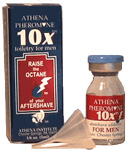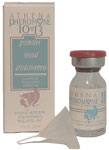
By Taryn Hillin
link to original article
I Wore ‘Pheromone Perfume’ For A Week To Turn Myself Into A Sex Goddess
Copyright 2015. fusion.net
After years of going to the gym and working out in silence, one day, my male kickboxing partner wanted to talk. "What do you do for a living?" the stranger asked. "Do you live by the beach?" And then he told me: "I've never boxed with someone who smells so nice!"
I wasn't wearing a skimpier top than usual…. The only thing I'd changed was my perfume. For a week, I'd been wearing synthetic pheromones "guaranteed" to make me more attractive to other humans.
I soon found myself having full-on conversations with both men and women while running the gym's stairs and lifting weights. Uber drivers struck up conversations. Bartenders smiled at me, and one night, a girl walked across a room to tell me she loved my plain black dress. I also got compliments on my unwashed hair.
"Pheromone perfumes" have been around since the 1990s, but as a reporter who covers the science of love, I was curious to test-drive a few of the so-called love potions myself. So I ordered three different formulas and took them for a spin in a highly unscientific yet enlightening experiment. We spend so much time obsessing over how to make ourselves more attractive—but has the secret been under our noses this whole time?
Bottled sex appeal
The story of pheromone perfumes is, in many ways, the story of pheromones themselves—which first became a household name nearly thirty years ago, when a biologist named Winifred Cutler and her team announced they had proven the existence of the so-called attraction chemicals in humans in a study.
For those unfamiliar, pheromones are chemicals secreted by an animal that change the behavior of another animal of the same species. There's a misconception that pheromones are equivalent to a scent—but really, we "detect" them more than we "smell" them. Research has shown without a doubt that pheromones are real throughout the animal kingdom, but their history in humans is more controversial.
But back to Cutler. Her study, published in the journal Fertility and Sterility in April 1986, found that women who had sex with men frequently—at least once a week—were more likely to have normal menstrual cycles and fewer infertility problems than women who were near celibate or had sex irregularly. According to Cutler, this correlation proved that the women in the study were receiving chemical signals from men that were, in turn, affecting their fertility.
"We had discovered that something in the behavior was affecting fertility, now we had to figure out what in this big soup would be the formula for pheromones," said Cutler, who earned a doctorate in biology from the University of Pennsylvania and conducted postdoctoral work in behavioral endocrinology at Stanford University.
At that stage, Cutler couldn't yet identify a specific chemical that was responsible for human pheromones—but over the next five years, she and her colleagues set out to find it.
And they did, allegedly, through a series of experiments. In one relatively famous study on the path to identifying the chemical, Cutler collected armpit secretions from fertile men and women and froze them. A year later, she and her team thawed the secretions and placed them on the mustache region of a different set of subjects. The researchers found that the secretions from heterosexual, fertile men and women increased the frequency of sociosexual behaviors such as kissing, petting, dating, and intercourse in their heterosexual subjects.
Despite her big discovery, Cutler has yet to disclose what the mysterious chemical is. In 1993, however, she patented a pheromone formula containing the chemical, which promised to help women attract men, naming it the Athena Pheromone(™). She soon began selling her "pheromone perfume" through the Athena Institute for Women's Wellness in Pennsylvania, a biomedical research organization that she founded in the eighties. In 1995, she began selling a pheromone formula to help men attract women as well.
Today, both varieties are available to order through the Athena Institute's website, and both promise to "increase the romantic attention you get" from men or women.
Science or snake oil?
Cutler says her formula contains a chemical copy of a human sex pheromone. It comes in a tiny blue bottle, runs about $100, and smells like rubbing alcohol. Since it's technically a cosmetic, not a drug, it doesn't require the approval of the Food and Drug Administration—and indeed, it is not regulated by the group. "It is the cosmetic company's responsibility to substantiate product and ingredient safety prior to marketing," an FDA spokesperson explained in an email.
After Cutler's formula went on the market, three studies were conducted to test it—one in which Cutler was involved plus two independent, double-blind, placebo-controlled studies, which strongly suggested her pheromones played some role in sexual attraction.
The first, which involved Cutler and which was published in the Archives of Sexual Behavior in 1998, studied 38 heterosexual men. Men who wore the pheromones saw an increase in frequency of sexual intercourse and sleeping next to a romantic partner, as well as more instances of kissing, petting, affection, and informal dates.
The second study, published in Physiology and Behavior in 2001 and conducted independently at San Francisco State University, focused on 36 women. It found that ladies who wore pheromones got more formal dates than women who did not. Researchers also found that "Three or more sociosexual behaviors increased over baseline for 74 percent of pheromone users compared with 23 percent of placebo users." The increase in sociosexual behaviors included sexual intercourse, sleeping next to a romantic partner, and petting/kissing behaviors.
The third study, published in 2004 in the Journal of Sex Research, tested the pheromones' affect on postmenopausal women. The researchers again found that "sociosexual behaviors increased over baseline."
Separately, in 2005, ABC's 20/20 did their own informal test of Cutler's pheromones using twins, and the show found that the twin who wore the formula during a speed dating session got nearly twice as many dates. (Disclosure: ABC is a parent company of Fusion.)
Cutler stands by her product, which she says has a huge fan base of loyal customers who reorder her month after month. "Athena Pheromones are like cosmetics," she told Fusion. "You put it on and it makes you more attractive."
The case against pheromones
"Cosmetic" may be the key word. Many scientists don't buy that pheromones—let alone "pheromone perfumes"—play a role in our love lives.
"In humans there is very limited evidence that we use pheromones to attract members of the opposite sex (let alone dictate 'love')," Richard Benton, an associate professor at the Center for Integrative Genomics in Switzerland who has studied sex pheromones extensively, told Fusion.
"There is some doubt as to whether humans can detect pheromones, as we lack a functional version of the sensory organ that other mammals use," he explained, referring to the vomeronasal organ, which contains sensory neurons that many mammals use to detect chemical stimuli that influence mating behaviors.
Other experts agreed that while pheromones themselves are very real in the animal kingdom—from mammals to insects—it may be a stretch to say they influence human behavior. "In mice and other animals, pheromones clearly play an important role in social behavior. However, pheromone effects in humans remain a matter of scientific debate," said Steve Liberles, an associate professor of cell biology at Harvard Medical School. "Specific chemicals have been proposed to function as human pheromones, but the evidence is weak."
Benton said one of the chemicals thought to possibly act as a pheromone in humans is the steroid androstenone, which is found in sweat and urine. "Androstenone has been shown to act as a pheromone in pigs—when a female pig smells this in males, she assumes the mating stance—but there is no clear data on what androstenone might do in humans." (Cutler will neither confirm nor deny whether her formula contains androstenone.)
Cutler's competition
While Cutler may be the only Ivy League biologist claiming to sell bottled human pheromones, she's hardly the only entrepreneur profiting from the concept of the chemicals. A quick search on Amazon reveals dozens of products with names like "Pure Instinct" and "Naughty Secrets," all of which promise to make you more attractive to the opposite sex.
Pure Instinct and Naughty Secrets are both sold by adult erotica companies, which also sell pheromone-free adult products. Others, like PherX (a pheromone I tried), only sell pheromones—a formula its website says was created by "a team of doctors in biology and pharmacology," though I was unable to independently verify this claim. (The company did not respond to interview requests.)
I was inspired to try the pheromones for myself in part thanks to the products' surprisingly glowing Amazon customer reviews. Many have four out of five stars, and many buyers seem to believe the pheromones work, at least in the sense that people (of both genders) were nicer to them. Many women claimed their boyfriends and husbands were more attentive. Words like "nuzzling" and "cuddling" were often used to describe the interactions:
Now, does it really work? I honestly believe so. Since wearing it on an almost daily basis, my boyfriend (whom I live with)has been more physical. ******
What was going on here? For my experiment I ordered one bottle of Cutler's formula and two from Amazon with great reviews: PherX and Scent of Eros, the latter of which was developed by a researcher named James Vaughn Kohl, who describes himself online as a "medical laboratory scientist" who has "devoted more than twenty-nine years to researching the relationship between the sense of smell and the development of human sexual preferences." (When asked for additional credentials, Kohl directed me back to his website.) While Cutler's had no scent at all, PherX had a particularly strong, musky smell and Scent of Eros smelled nice and floral.
According to the label, PherX contains a blend of the previously mentioned androsterone, androstadienone (a metabolite of testosterone), androstenol (a sex pheromone found in pigs, as well as humans in small quantities), estratetraenol (a chemical compound produced by women), and copulins (which I'll explain in a moment).
Scent of Eros is made entirely with copulins, which several pheromone websites claim are chemicals secreted by the vagina during ovulation that make men more aroused. I couldn't find much actual science behind them, save for one paper written in 1975, which said copulins were known sex attractants in Rhesus monkeys but also had arousal effects on human males. One other paper from 1997 also briefly mentioned them. But when I asked Liberles, the professor from Harvard, for more information on copulins, he said he had never heard of them. Benton, too, said they had "no proper scientific foundation."
Wearing the love potion
Cutler told me that her pheromones are not instant—they work better the longer you wear them, so I wore them for more than a week, applying them daily to my mustache area (my upper lip), as well as on my neck and under my ears.
The verdict of my highly unscientific study? I am not sure if men were more attracted to me, but people were definitely nicer while I was wearing Cutler's formula. But perhaps more notable, I walked around feeling like everyone liked me. ******I've worn it to work and out shopping, and no…men are not chasing me down….But…that being said, there are some things about this product that I know I will order it again. First…the way it makes ME feel. I do not believe it's a placebo effect,because if it was, I'd have been discouraged that men weren't chasing me down and I'd have stopped wearing it. But, somehow, it does affect ME. It makes me feel more confident and alive. Makes me feel happier a few minutes after I put it on. Makes me feel how I felt when I was younger. I don't know if I'm sexier with it, but I darn well FEEL sexier…And it's a good feeling. Placebo effect or not, I like the feeling. I will reorder.
Of course, these "changes" could have been a placebo effect, as the customer above mentions. Perhaps I felt like I had a secret weapon—that people wanted to talk to me because I was wearing a magic formula, which is how I thought of the pheromones. (The twins mention this feeling in the 20/20 experiment as well). Wearing pheromones could have simply made me more likable and open. Maybe I was flashing the first smile without even realizing it.
*******
However, I didn't experience the same friendly effects with the two bottles from Amazon. Again, this could be placebo effect—Cutler's formula comes with a biologist's approval and several studies to back it up, not to mention her bottles are very sleek and cool looking. The other two bottles were cheesier, with bright colors and an "I bought this at CVS" vibe. My brain was probably aware of that.
There's also the price difference and the bias it might have instilled. Cutler's pheromones run about $100 for a couple ounces, whereas the two from Amazon were in the $30 to $50 range. Amazon reviewers, meanwhile, reported positive results from the cheaper varieties.
They liked me—they really liked me?
Even if the niceness was in my head, there's something to be said for feeling like people wanted to talk to me. We all know confidence is sexy, and I can say without a doubt that I felt more confident with pheromones than without them. Like any good cosmetic, Cutler's pheromones made me believe I was more attractive—a belief that became a self-fulfilling prophecy.
Would I be willing to regularly shell out hundreds of dollars to feel that way? For now, I think I'll stick with the endorphin rush I get from my once-again chat-free gym workouts.
30-30
Athena Institute chose the deletions and the emphases. For Ms. Hillin's full online article see fusion.net/story/121686/do-pheromone-perfumes-really-work/
Dr. Cutler's pheromone science has been "bottled" into vials of unscented fragrance additives that increase wearers' sexual attractiveness. AVAILABLE FOR PURCHASE HERE

